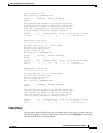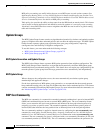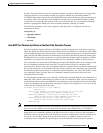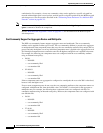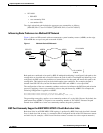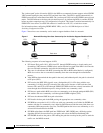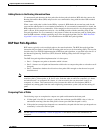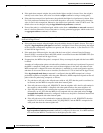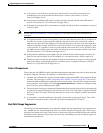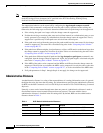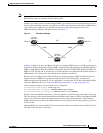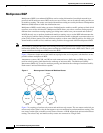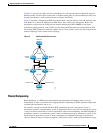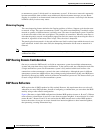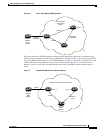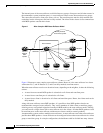
Implementing BGP on Cisco IOS XR Software
Information About Implementing BGP on Cisco IOS XR Software
RC-29
Cisco IOS XR Routing Configuration Guide
OL-14356-01
9. If one path is received from an external peer and the other is received from an internal (or
confederation) peer, the path from the external peer is chosen. (See Section 9.1.2.2d of
draft-ietf-idr-bgp4-24.txt.)
10. If the paths have different IGP metrics to their next hops, the path with the lower IGP metric is
chosen. (See Section 9.1.2.2e of draft-ietf-idr-bgp4-24.txt.)
11. If the paths have unequal IP cost communities, the path with the lower IP cost community is selected
as the best path.
Note See the “BGP Cost Community” section on page RC-22 for details on how cost communities are
compared.
12. If all path parameters in Step 1 through Step 10 are the same, then the router IDs are compared. If
the path was received with an originator attribute, then that is used as the router ID to compare;
otherwise, the router ID of the neighbor from which the path was received is used. If the paths have
different router IDs, the path with the lower router ID is chosen. Note: where the originator is used
as the router ID, it is possible to have two paths with the same router ID. It is also possible to have
two BGP sessions with the same peer router, and therefore receive two paths with the same router
ID. (See Section 9.1.2.2f of draft-ietf-idr-bgp4-24.txt.)
13. If the paths have different cluster lengths, the path with the shorter cluster length is selected. If a
path was not received with a cluster list attribute, it is considered to have a cluster length of 0.
14. Finally, the path received from the neighbor with the lower IP address is chosen. Locally generated
paths (for example, redistributed paths) are considered to have a neighbor IP address of 0. (See
Section 9.1.2.2g of draft-ietf-idr-bgp4-24.txt.)
Order of Comparisons
The second part of the BGP best-path algorithm implementation determines the order in which the paths
should be compared. The order of comparison is determined as follows:
1. The paths are partitioned into groups such that within each group the MED can be compared among
all paths. The same rules as in the “Comparing Pairs of Paths” section on page RC-27 are used to
determine whether MED can be compared between any two paths. Normally, this comparison results
in one group for each neighbor AS. If the bgp bestpath med always command is configured, then
there is just one group containing all the paths.
2. The best path in each group is determined. Determining the best path is achieved by iterating through
all paths in the group and keeping track of the best one seen so far. Each path is compared with the
best-so-far, and if it is better, it becomes the new best-so-far and is compared with the next path in
the group.
3. A set of paths is formed containing the best path selected from each group in Step 2. The overall
best path is selected from this set of paths, by iterating through them as in Step 2.
Best Path Change Suppression
The third part of the implementation is to determine whether the best-path change can be suppressed or
not—whether the new best path should be used, or continue using the existing best path. The existing
best path can continue to be used if the new one is identical to the point at which the best-path selection
algorithm becomes arbitrary (if the router-id is the same). Continuing to use the existing best path can
avoid churn in the network.



